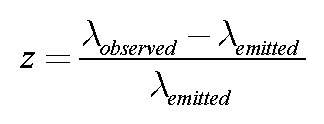The first evidence of the Big Bang came from Edwin Hubble. His observations included estimating the distances of the galaxies form our own. His observations on the light from the galaxies provided intriguing information. Hubble observed that absorption lines in the spectrum were almost always "shifted" to longer wavelengths the redder area of the spectrum. Hubble called it "redshift."
The wavelengths tend to stretch as an object moves away from the observer. For example, a police car with it's sirens on will tend to change it's pitch as the car moves towards you and away from you. This is called Doppler shift.This is because the wavelengths of the sound changes as the waves come towards you and away. The waves coming towards you tends to be shorter in wavelength and the waves moving away from you have longer wavelengths.
Now, using galaxies, the Doppler shift works the same way. Galaxies (i.e The Andromeda Galaxy) coming towards us have wavelengths shorter than what they are originally supposed to be. Distant Galaxies on the other hand are moving away from us, causing their waves to be longer than originally measured. The wavelengths tend to stretch as an object moves away form the observer.
Hubble measured the amount of the shift in the spectra from the galaxies. He was able to calculate the recession velocities of the galaxies. This measurement is known as Hubble's Law. Hubble's Law = The velocity at which a galaxy is moving away from us is proportional to the distance of that galaxy.
Hubble's Law: V= H x D
- V: The velocity of recession
- H: Hubble's constant
- D: distance of galaxy
In order to be able to solve the law, data must be obtained. Hubble's constant is the result of comparing and observing the distance of many galaxies and compared the distances to the recession velocities of the galaxies. Hubble's constant is 22 km/s/mly
The distance of galaxies cannot be precisely measured, but astronomer have a good estimate of how far away the galaxies are. They use many methods, such as determining the parallax shift and the brightness of stars within galaxies. Parallax is the visual effect produced when nearby objects appear to shift position relative to more-distant objects. These indirect measurements of the distance of galaxies often fail when it is applied to distant galaxies. Distant Galaxies are observed by their intrinsic brightness, the amount of light actually emitted by the object.
 |
| A great picture, showing what astronomers use to discover the distance of celestial objects such as stars and galaxies |
However, a much more accurate distance measurement can be made from the redshift of a galaxy. This is called the Velocity-Distance relation, and it makes it possible to infer the distance of an object from a measurement of its spectrum. The amount of the shift varies directly with the actual distance to the object. This is one of the reasons why redshift is so important.
 |
| The definition of redshift |
After calculating the distance and Hubble's constant, a close estimate of the velocity of the recession of the galaxy can be made.
Hubble's law seems to imply that we are sitting at the center of the explosion, with everything moving away from us, but the expansion looks the same from any point in the universe. Hubble's law not only shows that the Universe is expanding, but we can also use the rate to determine how long this expansion has been occurring.
If we measure the distance between two galaxies and then divide the distance by the velocity of recession, then we can be able to determine how long it took for the the galaxies to reach their current distance.
For example, a galaxy 100 million light years (mly) away with a velocity of recession of 2,200 km/s would take 13.6 billion years to reach it's current distance.
Because more distant galaxies also move apart faster Hubble's law says any two galaxies reach their present separation in the same 13.6 billion years. This means that the Universe is around 14 billion years old.
This was a generally easy summary, and I did not have much questions on the expansion of the universe and redshift. I have done a lot of background reading on this topic before and this made sense to me. However I did have some questions. What is the Velocity-Distance Relation? The sources did not give much information about the exact relation. Another question was that how do astronomers really determine the time galaxies take to reach their current distance? I tried using the same format (100 mly / 2,200 km/s) and I did not end up with 13.6 billion years. I ended up with something more like .045 mly/km/s. I don't know if I am doing the math right, or if there is much more advanced math needed.



how are redshift and telescope's related?
ReplyDelete